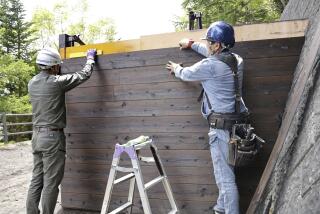Nagano’s only-in-Japan touches
- Share via
Reporting from Nagano, Japan
Fame is fleeting, but mountains are eternal. Or so it seems in Nagano, the mountain-ringed city in the center of Honshu, Japan’s main island.
Nagano had a brief brush with international fame when it hosted the 1998 Winter Olympics, but the city center has returned to its former self, a comfortably modern medium-size downtown spread out below the imposing Zenkoji Buddhist Temple. But the mountainous prefecture, or administrative region, encircling it seems ancient, with its Shinto shrines, hot springs and villages trapped in time.
Mountains throughout the prefecture, nicknamed the Roof of Japan, boast charms for all seasons, but especially before the June rainy season, which makes for sticky summers. Here are three day hikes, some of my favorite excursions in the last decade, easily reached by bus or train from the prefecture’s two main cities, Nagano and Matsumoto.
Togakushi
In Japan’s native Shinto religion, mountains can be kami (gods), and three Shinto shrines, each separated by a couple of miles, salute the region’s holiest, Mt. Togakushi (toh-GOCK-shee, 6,270 feet), northwest of Nagano. The two upper shrines, Chusha and Okusha, are the more dramatic.
From Nagano, I took the bus up the aptly named Togakushi Birdline Highway toward Okusha, said to date from 849. From the bus stop, it’s a walk of a little more than a mile through the woods, much of it along the 2,300-foot Suginamiki, an alley of towering 400-year-old cedars that’s as rhythmic as a Venetian arcade. I paused to contemplate the impressively gnarled and intertwined roots.
By the time I reached the final steps up to the shrine, I was winded from the elevation, but climbing alongside me were obaasan and ojiisan (grandmas and grandpas), so no whining. The reward: views across the plateau to the surrounding mountains, not to mention communing with a kami.
Back by the bus stop is a museum of ninpo, the craft of the ninja, part of the campus of the Museum of Togakushi Folklore. In this cluster of buildings are shuriken (spiky, disc-shaped darts) and other ninja weaponry, but my favorite part was the “ninja house” with one room tilted on an angle (amazingly difficult to maneuver) and a maze with no discernable exit. The museum and nearby shops are closed during winter snows, although the trail is accessible to snowshoers.
The trail to Okusha starts at Chusha, the intimate middle shrine, reachable by road year round. At Chusha, a steep staircase leads to a terrace and a cryptomeria cedar said to be 700 years old. At the base of the stairs, stop for soba noodles, Togakushi’s signature dish, served in a light dashi (fish stock-based) broth.
Nakasendo Road
During the Edo Period (1605-1868), feudal lords, or daimyo, and their retainers and samurai protectors traversed Japan using trunk roads. The most famous of these was the Tokaido, along the Pacific coast (chronicled in a series of woodblock prints by Hiroshige); another route, the Nakasendo, served mountain provinces.
Modernity has nearly obliterated the Tokaido but bypassed much of the more remote Nakasendo, making it one of the few places where visitors can still feel the presence of Edo-era Japan, even if the palanquins and rice-straw sandals have been replaced by backpacks and hiking shoes.
The best preserved of the Nakasendo post towns, where nobles bedded down between days on the trail, is Tsumago, now reachable by train from Matsumoto followed by a quick bus or taxi ride. The architect I was traveling with practically had to drag his jaw off the floor of some of the feudal buildings, especially the honjin (daimyo‘s lodgings). Tsumago is closed to car traffic, so the wood-fronted streetscape feels like a movie set. (In fact, several films have been shot here.)
The best way to sense the Nakasendo, though, is to walk it. Go to the next post town, Magome, by bus or taxi and walk to Tsumago, about five miles away (less uphill in this direction). Hidden waterfalls and swaying rice terraces along the route are great places to break. Even better, if you can spend the night, a stay at one of Tsumago’s wooden ryokan (traditional inns) will take you back in time as tour buses vanish and morning mist settles in mountain crevasses.
Japan Alps National Park
The Azusa River runs through this park and the valley known as Kamikochi, nationally renowned for the peaks that encircle it.
Getting here involves a train-bus combination that takes almost two hours from Matsumoto. It’s worth it. Kamikochi’s peaks are a haven for mountain hikers, technical climbers and trekkers. In clear weather, from the summits, you may see Mt. Fuji, Japan’s tallest peak, about 90 miles away. Even day trippers will find plenty to see in nature and the only-in-Japan touches along the rushing river.
Tourist hotels and restaurants around Kamikochi’s bus terminal soon give way to a forest of cedars and sasa (bamboo grass). The mirror-like pond Myojin-ike is part of the shrine to Mt. Hotaka, as perfect as any temple garden in Kyoto. Ninety minutes more of walking along the river bank and you’ll arrive at Tokusawa, where a hotel/campground serves simple meals before you double back to the bus terminal.
Kamikochi is accessible only from April to mid-November, but the rest of the national park is open year-round. Buses operated by Nohi Bus Co. run from Matsumoto to the village of Hirayu Onsen, where hot spring lodges and small inns soothe the bones of weary hikers and stressed-out city folk. There’s even a hot spring bath at Hirayu Onsen’s bus terminal. The inn Hirayu no Mori has 16 pools, indoors, outdoors and even a foot bath.
From Hirayu Onsen, another bus connects to Shin-Hotaka, where the Ropeway (a series of gondolas) takes you up sacred Mt. Hotaka. Views are breathtaking as you soar above the pines, and last winter I got the added bonus of hiking through lanes carved from shoulder-high snow. Just be sure to take the right clothing and especially the right shoes.
More to Read
Sign up for The Wild
We’ll help you find the best places to hike, bike and run, as well as the perfect silent spots for meditation and yoga.
You may occasionally receive promotional content from the Los Angeles Times.






